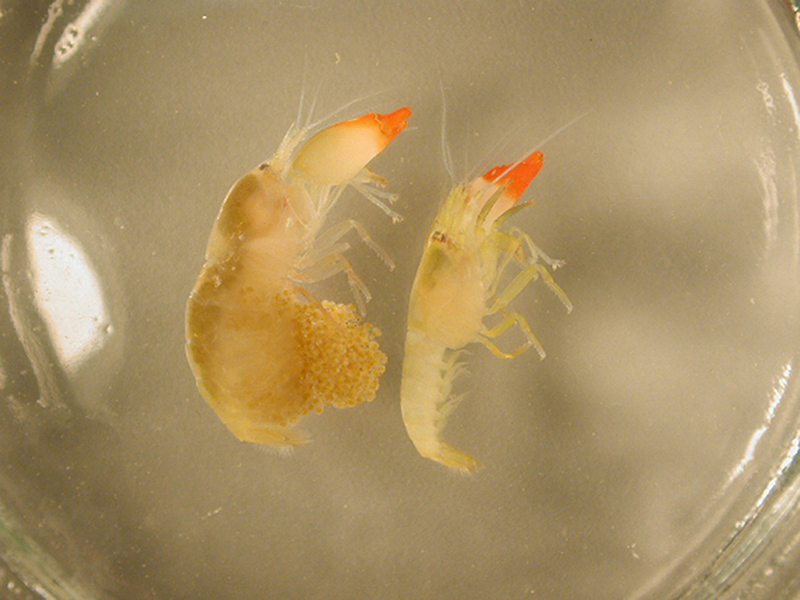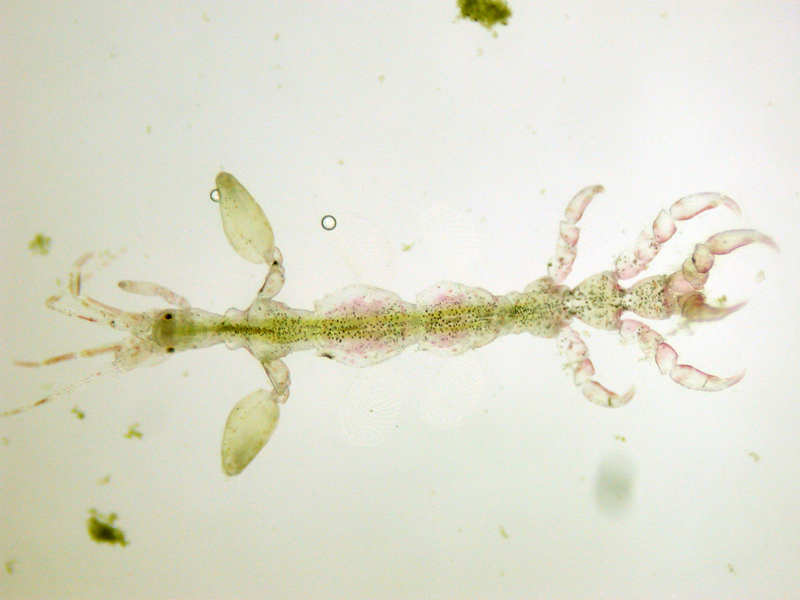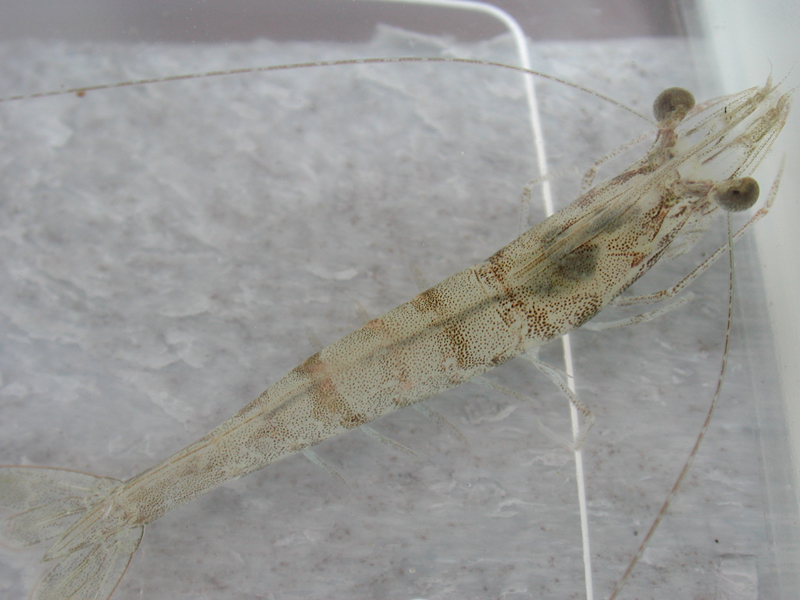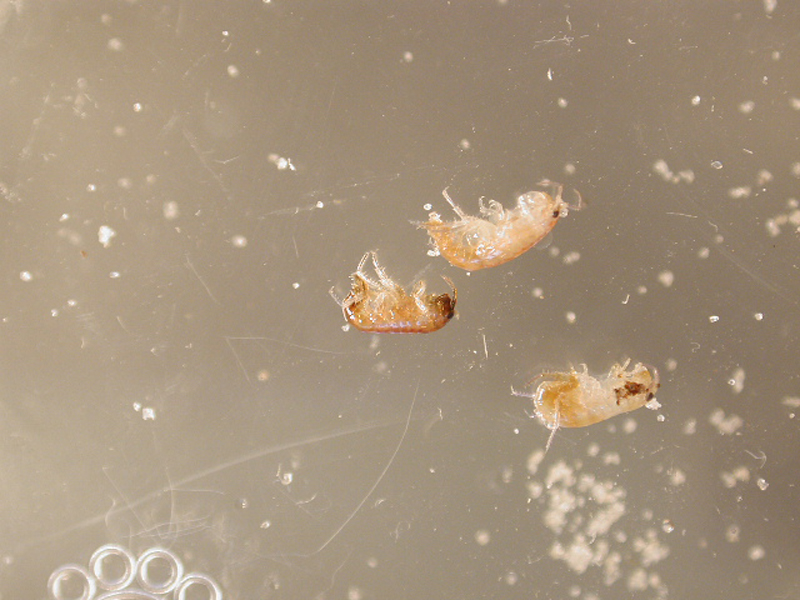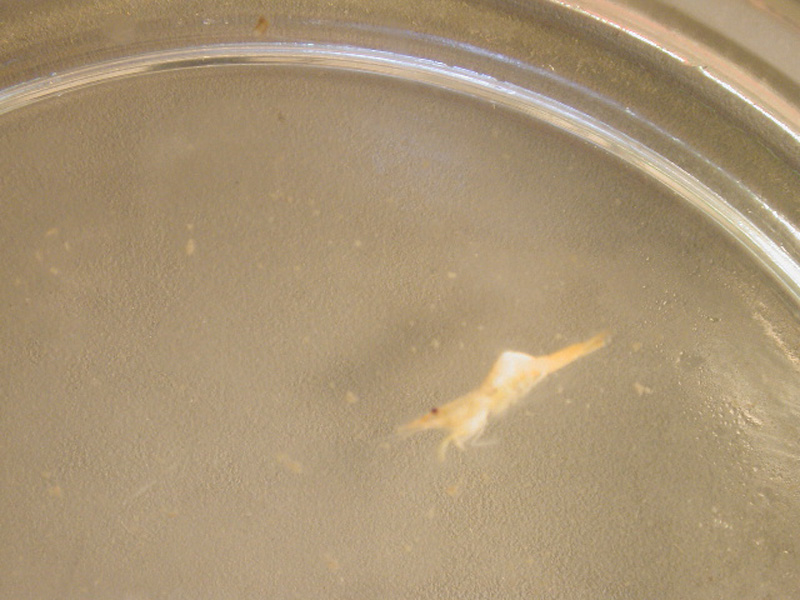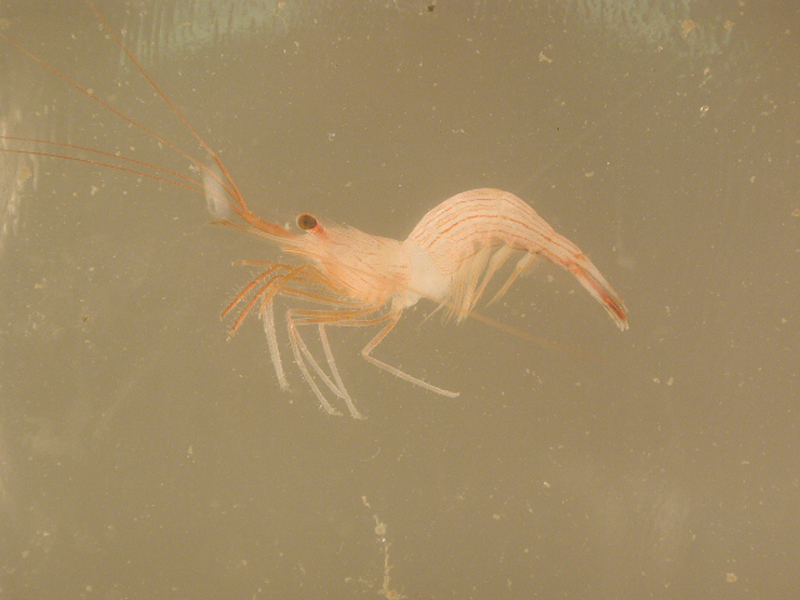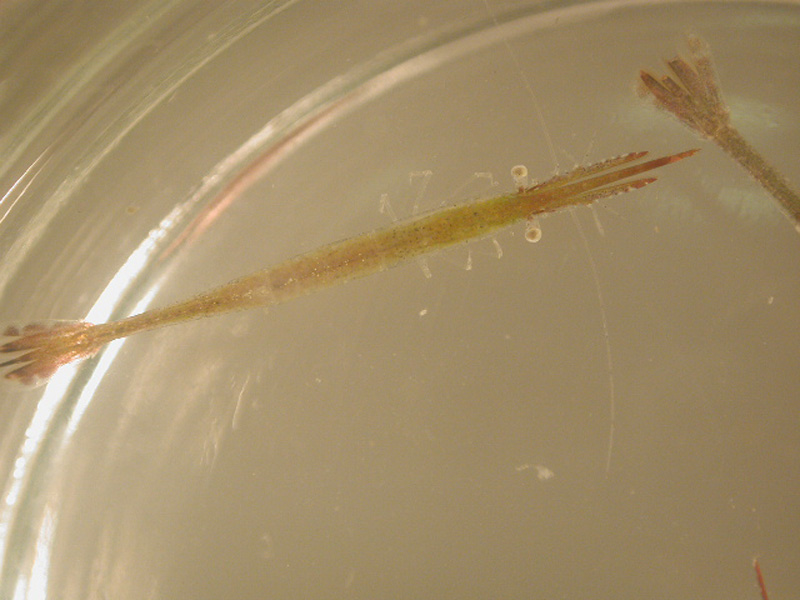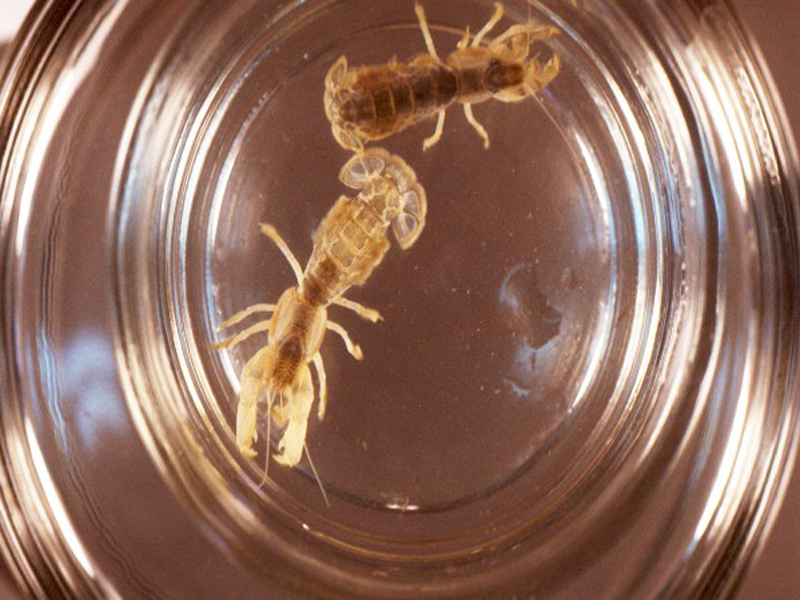Shrimp-like
Snapping Shrimp
Description
The snapping shrimp, while very common from North Carolina to the West Indies, is rarely seen, though often heard. Usually hiding among oyster reefs and other hard structures in intertidal zones, snapping shrimp, also called pistol shrimp, use an enlarged claw to make a loud snapping noise. This can be used to fend off predators or stun prey, and has been known to break glass in aquaria. The big-clawed snapping shrimp is the largest in the area, reaching up to 2 inches in carapace length, and has a green color to the body, black and white markings on the claws, red walking legs, and orange and blue lines along the tail. It also has two distinct notches in the large claw, at the base of the fingers.
What Are The Effects On Clams?
These shrimp will catch and consume some of the smaller predators found in clam bags, such as small mud crabs, but will also consume some animals that can be beneficial to clams such as other small shrimps.
- FRIEND
What Can A Clam Farmer Do?
No action needs to be taken by a clam farmer.
Skeleton Shrimp
Description
Skeleton shrimp are found on hydroids, bushy algae, and other growth, near the low-tide line and below. These crustaceans have a pale buff or tan to greenish color. They have small, round eyes and a long, slender, arched, jointed body with a rounded head at the front. The first antennae are 1/3 the body length and twice the length of the second antennae. First and second thoracic appendages appear as grasping claws. A pair of saclike gills is found on the next two segments and the last 3 segments have bristly grasping appendages directed backward. Skeleton shrimp are small, ranging from ¾ of an inch to 2 inches in length, and are very narrow in width.
What Are The Effects On Clams?
These tiny crustaceans may be found in high numbers on clam bags or on other organisms fouling clam bags, but present no problem for the clams themselves.
- NEIGHBOR
What Can A Clam Farmer Do?
No action needs to be taken by a clam farmer.
Pink Shrimp
Description
The pink shrimp comprises one of the largest commercial marine fisheries in the world. It is an extremely common shrimp in inshore waters from Virginia to Mexico, and can reach up to 10 inches long. The antennae of this shrimp are much longer than the body, and this genus is separated from most others by having three pairs of small pincers. As the name implies, it is colored a translucent pink, and has a distinct groove running the length of the carapace (the shell covering the head). There is a dark spot on either side of the abdomen between the 3rd and 4th segments, and has a long, sharp rostrum above the head, with about 10 spines on top and 2-3 on the bottom. Larvae of this shrimp grow in estuarine waters, then move offshore as adults to spawn. It is these spawning grounds that are used by fishermen for large catches.
What Are The Effects On Clams?
This common shrimp helps clams in two ways. Aeration of the sediment and oxidation of sulfides occurs when it burrows into the sediment. At night, they come out to feed on organic wastes, such as accumulated clam feces and pseudofeces, removing these wastes from the clam lease.
- FRIEND
What Can A Clam Farmer Do?
No action needs to be taken by a clam farmer.
Beach Flea
Description
Beach fleas are small amphipods, rarely reaching above ½ inch in length. They are common all along the Atlantic and Gulf of Mexico coasts. They have a brown to translucent color, and feed on detritus, decaying algae and grass. They can often be seen swarming underneath rocks and dead weed lines along the beach. Lying on their side, beach fleas remain under shelter, but when disturbed, they jump and/or swim away quickly, often jumping like fleas.
What Are The Effects On Clams?
These small crustaceans are detritivores, meaning that they feed on organic wastes. In doing so, they can consume clam feces and pseudofeces, removing these wastes from the clam bag.
- FRIEND
What Can A Clam Farmer Do?
No action needs to be taken by a clam farmer.
False Zostera Shrimp, Broken Back Shrimp
Description
The false zostera, or broken back, shrimp is often found among shallow water vegetation from Connecticut to Texas. It is very small, only ½ inch in length, and ranges from brown to green in color, to match the color of the seagrass it lives in, especially eelgrass. The first and second pairs of legs are modified into claws, the second pair being bigger. So-called because of the sharp bend of the abdomen at the third segment, giving it the appearance of a broken back, the shrimp also has tufts of hair on the back side of the abdomen and carapace.
What Are The Effects On Clams?
These small shrimp consume bits of algae and can be beneficial in keeping clam bags clean.
- FRIEND
What Can A Clam Farmer Do?
No action needs to be taken by a clam farmer.
Gribble
Description
These species of isopods are common, though discreet, crustaceans, rarely reaching over ¼ inch in length. They range from New England to South America, and are almost cylindrical in shape. They are wood borers, well known for causing heavy destruction in unkempt wood such as boats, pilings, and flotsam. Often times, they are the reason for the numerous holes in driftwood found washed ashore, or for the hourglass shape of dock pilings at the intertidal levels. Individuals are colored black and grey with white mottling, and can be dug out of the wood with a pocket knife.
What Are The Effects On Clams?
These "pillbug"-looking crustaceans can be found in clam bags adjacent to wooden pilings. Although they pose no direct threat to clams, they are very destructive to wooden structures.
- FOE
What Can A Clam Farmer Do?
As a deterrent, clam farmers can use PVC pipe for lease markers.
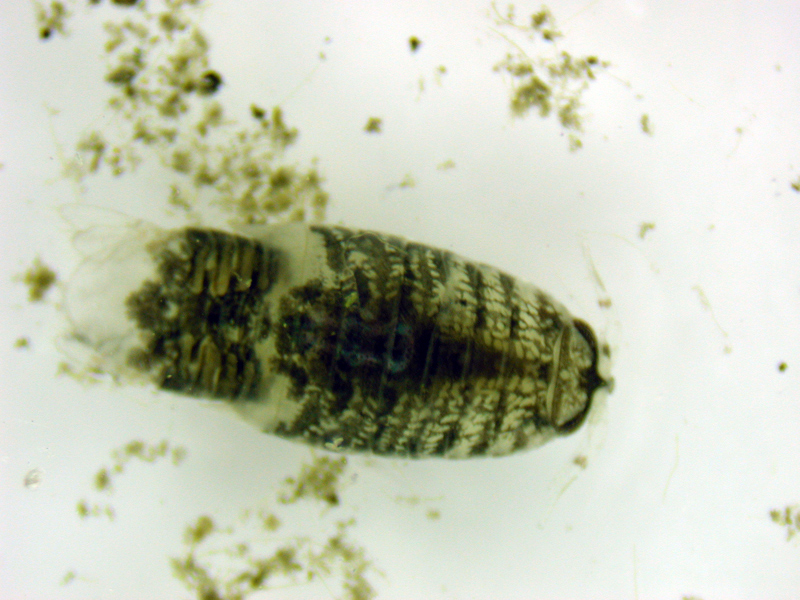
Taxonomy
- Kingdom:Animalia
- Phylum: ARTHROPODA
- SubPhylum: Crustacea
- Class: Malacostraca
- Order: Isopoda
- Family: Limnoriidae
- Genus: Limnoria
- Species: sp.
Peppermint Shrimp
Description
The peppermint shrimp is found on rocks, jetties, coral reefs, among hydroids on pilings and buoys and other structures from low-tide to water 100 feet deep. This shrimp is translucent white with longitudinal red stripes, edged with white, down the back and traverse stripes on the side. Its appearance is responsible for its common name. The peppermint shrimp can grow to a length of almost 3 inches and a height of ½ inch. This species and others of its genus act as cleaners, picking tissue debris and parasites off surfaces of fishes that actively seek them out.
What Are The Effects On Clams?
Peppermint shrimp remove and consume small parasitic organisms from substrates and can therefore be considered beneficial to have around clam leases.
- FRIEND
What Can A Clam Farmer Do?
No action needs to be taken by a clam farmer.
Daggerblade Grass Shrimp
Description
The grass shrimp is the most common shrimp-like species in seagrass beds and often found in brackish waters. This shrimp is transparent with claws present on the first and second legs with the second claws being the largest. The rostrum (knife-like, serrated structure projecting like a horn from the head) tapers to a sharp point and is toothed on the upper edge with three teeth present on the lower edge. The back in this species is straight. The grass shrimp can reach a length of 2 inches.
What Are The Effects On Clams?
Grass shrimp remove and consume small parasitic organisms from substrates and, therefore, can be considered beneficial to have around clam leases.
- FRIEND
What Can A Clam Farmer Do?
No action needs to be taken by a clam farmer.
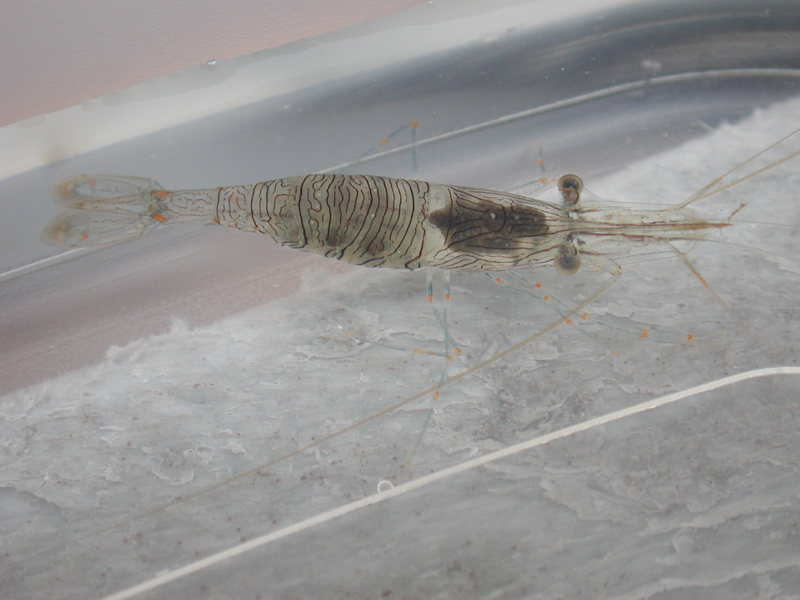
Taxonomy
- Kingdom:Animalia
- Phylum: ARTHROPODA
- SubPhylum: Crustacea
- Class: Malacostraca
- Order: Decapoda
- Family: Palaemonidae
- Genus: Palaemonetes
- Species: pugio
Southern Gribble
Description
The southern gribble is a common isopod in the southeastern U.S., found among intertidal rocks and seaweeds. It is identified best by microscope, noting that its hindmost appendages (uropods) reach to the very edge of the rounded tail, and that there are 4 teeth on the edge of each of the uropods. It can be seen in many different colors, including green, brown, and orange, and reaches 4/5 inches in length. Similar to backyard roly-polies or pillbugs, this isopod can roll up into a ball in defense.
What Are The Effects On Clams?
These "pill bug"-looking crustaceans can be found in clam bags adjacent to wooden pilings. Although they pose no direct threat to clams, they are very destructive to wooden structures.
- FOE
What Can A Clam Farmer Do?
As a deterrent, clam farmers can use PVC pipe for lease markers.
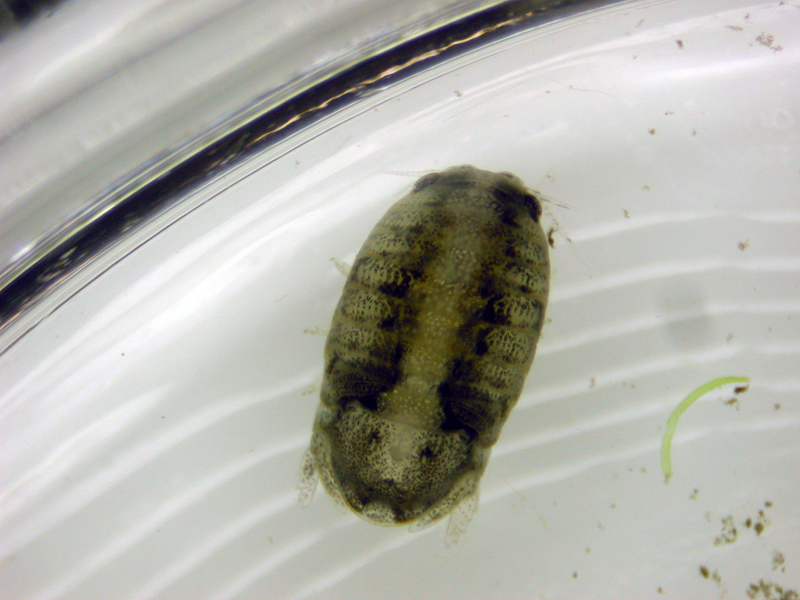
Taxonomy
- Kingdom:Animalia
- Phylum: ARTHROPODA
- SubPhylum: Crustacea
- Class: Malacostraca
- Order: Isopoda
- Family: Sphaeromatidae
- Genus: Sphaeroma
- Species: quadridentatum
Arrow Shrimp
Description
The arrow shrimp is a long, small, slender shrimp, found in the Gulf of Mexico and the Caribbean and North Carolina, though not in South Carolina or Georgia. It is usually colored a bright green to brown, depending on the grasses that it is living in. It reaches a length of about 2 inches, and is very common in shallow waters with vegetation or similar cover. Swimming in a vertical position, it is very well camouflaged among the grasses. The legs in general are short, with the first pair very short. The abdomen has a strong bend after the third segment, and the sharp rostrum (knife-like structure projecting like a horn from the head) is very long, taking a slight curve upward towards the very front. The top of the rostrum is smooth, while the bottom has up to 20 spines. In addition, there are two sharp spines at either side of the base of rostrum. The arrow shrimp feeds mainly on both plant and animal growths on and within sea grasses.
What Are The Effects On Clams?
This stick-looking shrimp consumes bits of algae and can be beneficial in keeping clam bags clean.
- FRIEND
What Can A Clam Farmer Do?
No action needs to be taken by a clam farmer.
Coastal Mud Shrimp
Description
The mud shrimp is found burrowed in sand and mud flats of the intertidal and subtidal zones, often under flat stones. This long, slender shrimp varies from almost pure white to a bluish or yellowish gray and resembles a miniature lobster with a fat abdomen and membranous shell. The first pair of antennae are small and the second pair are ½ the body length and bristle-like. The rostrum is squarish, flattened, and extends beyond its tiny eyes. The first pair of walking legs and carapace (shell over head and thorax) may be covered in a mat of fine bristles. The abdomen is large, twice the length of carapace, and separated from it by a deep constriction. The tail fan is also large. The mud shrimp can reach a length of 4 inches. This crustacean is not a true shrimp, but is more closely related to the hermit crab.
What Are The Effects On Clams?
Mud shrimp burrow into the sediment which can be beneficial; however, they are filter feeders and therefore can compete for the same types of food as clams (micro algae).
- FOE
- Competitor
What Can A Clam Farmer Do?
These shrimp are not found in high numbers and present little problem.
